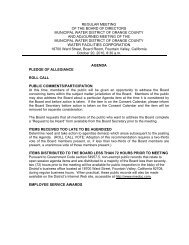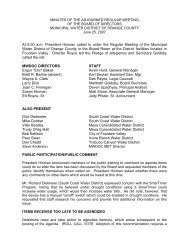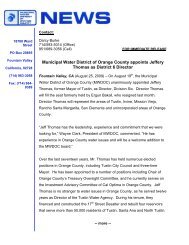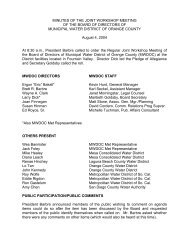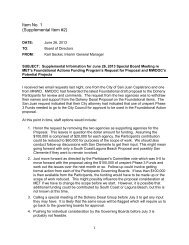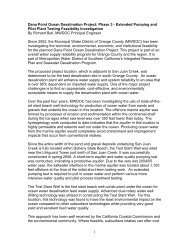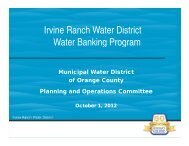UWM Plan - Municipal Water District of Orange County
UWM Plan - Municipal Water District of Orange County
UWM Plan - Municipal Water District of Orange County
You also want an ePaper? Increase the reach of your titles
YUMPU automatically turns print PDFs into web optimized ePapers that Google loves.
Section 3<br />
<strong>Water</strong> Sources and Supply Reliability<br />
La Habra Groundwater Basin Geology<br />
From a structural geology standpoint, the La Habra Basin area is dominated by the<br />
northwest trending La Habra Syncline (a U–shaped down–fold) which is bounded on the<br />
north by the Puente Hills and on the south by the Coyote Hills. The fold is a naturally<br />
occurring trough, or valley, where significant quantities <strong>of</strong> groundwater have<br />
accumulated over the past 150,000 years. The La Habra Groundwater Basin consists <strong>of</strong><br />
four major formations, which include bearing zones or aquifer units. These are the<br />
Alluvium, the La Habra Formation, the Coyote Hills Formation, and the San Pedro<br />
Formation.<br />
<strong>Water</strong> levels <strong>of</strong> wells in the La Habra Formation have been measured between 100 and<br />
200 feet below ground surface across the La Habra Basin area. <strong>Water</strong> levels in wells <strong>of</strong><br />
the Coyote Hills Formation have been measured at about 120 feet below the ground<br />
surface. Pressure levels <strong>of</strong> confined groundwater in wells <strong>of</strong> the San Pedro aquifer zone<br />
range from about 100 to 200 feet below ground surface.<br />
Currently, this non-adjudicated basin is serving the City <strong>of</strong> La Habra. The estimated longterm<br />
groundwater supplies from the basin have ranged from 3,700 AFY to 4,500 AFY;<br />
however, the historical City <strong>of</strong> La Habra extraction rate is approximately 1,074 AFY<br />
(averaged over the past 15 years). The City plans to utilize the additional groundwater<br />
supply by increasing the capacity on the existing Idaho Street Well.<br />
Full development <strong>of</strong> the La Habra Basin could eventually supply up to 40% <strong>of</strong> the City’s<br />
current water demands. The City <strong>of</strong> La Habra currently plans to double production<br />
capacity for the Idaho Street Well from 1,200 to 2,400 AFY, which will increase reliance<br />
on local sources from 11% to 22% <strong>of</strong> total demands. Table 2-12 shows projections for<br />
water extracted from the La Habra Groundwater Basin.<br />
3.3.4. Main San Gabriel Basin (California Domestic <strong>Water</strong> Company)<br />
The Main San Gabriel Basin lies in eastern Los Angeles <strong>County</strong>. The hydrologic basin or<br />
watershed coincides with a portion <strong>of</strong> the upper San Gabriel River watershed, and the<br />
aquifer or groundwater basin underlies most <strong>of</strong> the San Gabriel Valley.<br />
Surface area <strong>of</strong> the groundwater basin is approximately 167 square miles and has a fresh<br />
water storage capacity <strong>of</strong> the basin is estimated to be about 8.6 million acre-feet.<br />
The physical groundwater basin is divided into two main parts, the Main Basin and the<br />
Puente Subbasin. The Puente Subbasin, lying in the southeast portion is hydraulically<br />
connected to the Main Basin. However, it is not the legal jurisdiction <strong>of</strong> the Main San<br />
Gabriel Basin <strong>Water</strong>master, and is thus considered a separate entity for management<br />
purposes.<br />
<strong>Municipal</strong> <strong>Water</strong> <strong>District</strong> <strong>of</strong> <strong>Orange</strong> <strong>County</strong><br />
2010 Regional Urban <strong>Water</strong> Management <strong>Plan</strong><br />
Final<br />
3-30



